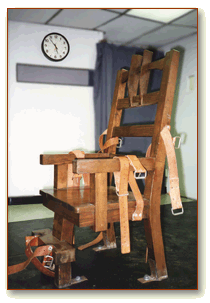 |
| Florida's electric chair |
TALLAHASSEE — For the first time in nearly two decades, a Florida prison inmate is demanding that he be put to death in the antiquated electric chair and not by a lethal injection method that has been repeatedly challenged in court.
Wayne Doty, 42, of Plant City has been on death row since 2011 after he killed a fellow inmate. In a state where condemned inmates routinely wait for decades to be executed, Doty wants to die immediately, partly to attain "spiritual freedom."
"I think his goal is to get put to death as quickly as possible," said Sean Fisher, a private investigator in Gainesville who once worked for Doty. "I think he's nervous about lethal injection being found unconstitutional."
The Florida Department of Corrections did not anticipate that an inmate would demand electrocution.
"We've received the inmate's request and we're reviewing it," prison spokesman McKinley Lewis said Thursday.
He declined to comment further.
Executions in Florida have been on hold for much of the past year because of lawsuits alleging that lethal injection is cruel and unusual punishment, and thus unconstitutional. But the U.S. Supreme Court has upheld its use and the next execution is set for next Thursday in the case of Jerry Correll, who killed four people in Orlando.
 |
| July 8, 1999. The botched execution of Allen Lee Davis* |
Florida is one of eight states, mostly in the South, that have kept the electric chair as a form of capital punishment.
Tennessee reinstated it last year because of challenges to lethal injections.
Florida's electric chair has long been known by the cynical nickname "Ol' Sparky." The three-legged chair has been idle for 16 years after a second botched execution forced the Legislature and then-Gov. Jeb Bush to change the method.
During the 1997 execution of Pedro Medina, who came to Florida from Cuba during the 1980 Mariel boatlift, a mask covering his face caught fire and filled the death chamber with smoke.
At the 1999 execution of triple murderer Allen Lee "Tiny" Davis, blood appeared on his face and shirt as 2,300 volts of electricity coursed through his 350-pound body. The state Supreme Court temporarily halted executions but later ruled in a 4-3 decision that electrocution was not a form of cruel and unusual punishment.
The state switched to a lethal injection of chemicals that sedate an inmate and stop the heart. But in changing the method of execution, Bush and the Legislature also gave inmates the one-time option of selecting electrocution.
Doty is the first inmate to do so.
In a handwritten affidavit, Doty wrote: "I'm invoking my right of free will to choose execution by electrocution due to confliction (sic) surrounding executions through lethal injection."
"My decision on method of execution is a self-driven motive allowing the state of Florida to exercise their duly sworn duties to deliver my sentence in an expeditious manner," Doty wrote, "thus bringing peace to the victim's family as well as my spiritual freedom."
Gov. Rick Scott has not issued a death warrant, but Doty has waived his right to all future appeals. The Department of Corrections says his execution can be scheduled at any time.
Source: Tampa Bay Times, Steve Bousquet, October 22, 2015
* July 8, 1999. Florida. The botched execution of Allen Lee Davis. "Before he was pronounced dead ... the blood from his mouth had poured onto the collar of his white shirt, and the blood on his chest had spread to about the size of a dinner plate, even oozing through the buckle holes on the leather chest strap holding him to the chair." His execution was the first in Florida's new electric chair, built especially so it could accommodate a man Davis's size (approximately 350 pounds). Later, when another Florida death row inmate challenged the constitutionality of the electric chair, Florida Supreme Court Justice Leander Shaw commented that "the color photos of Davis depict a man who -- for all appearances -- was brutally tortured to death by the citizens of Florida." Justice Shaw also described the botched executions of Jesse Tafero and Pedro Medina (q.v.), calling the three executions "barbaric spectacles" and "acts more befitting a violent murderer than a civilized state." Justice Shaw included pictures of Davis's dead body in his opinion. The execution was witnessed by a Florida State Senator, Ginny Brown-Waite, who at first was "shocked" to see the blood, until she realized that the blood was forming the shape of a cross and that it was a message from God saying he supported the execution.











